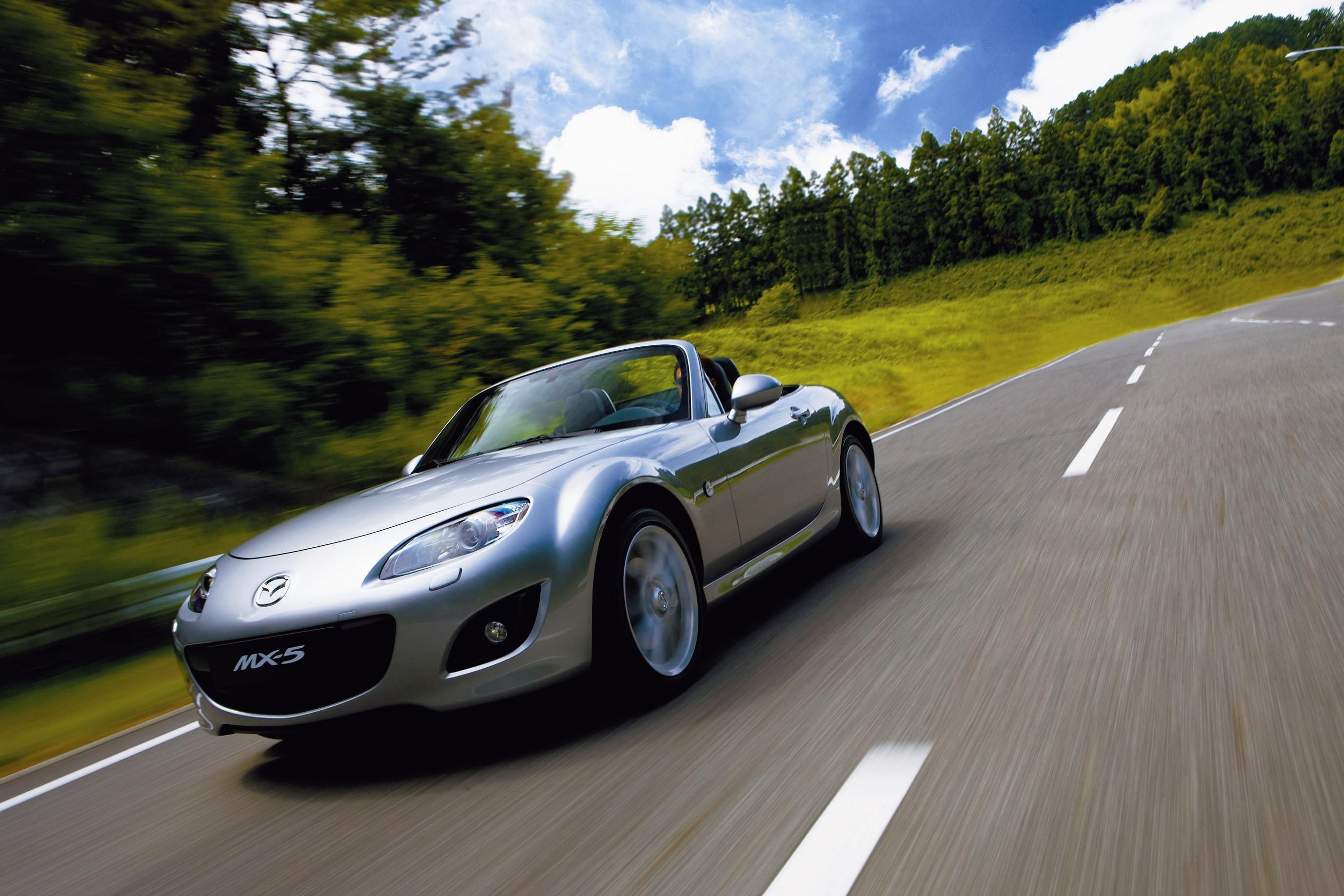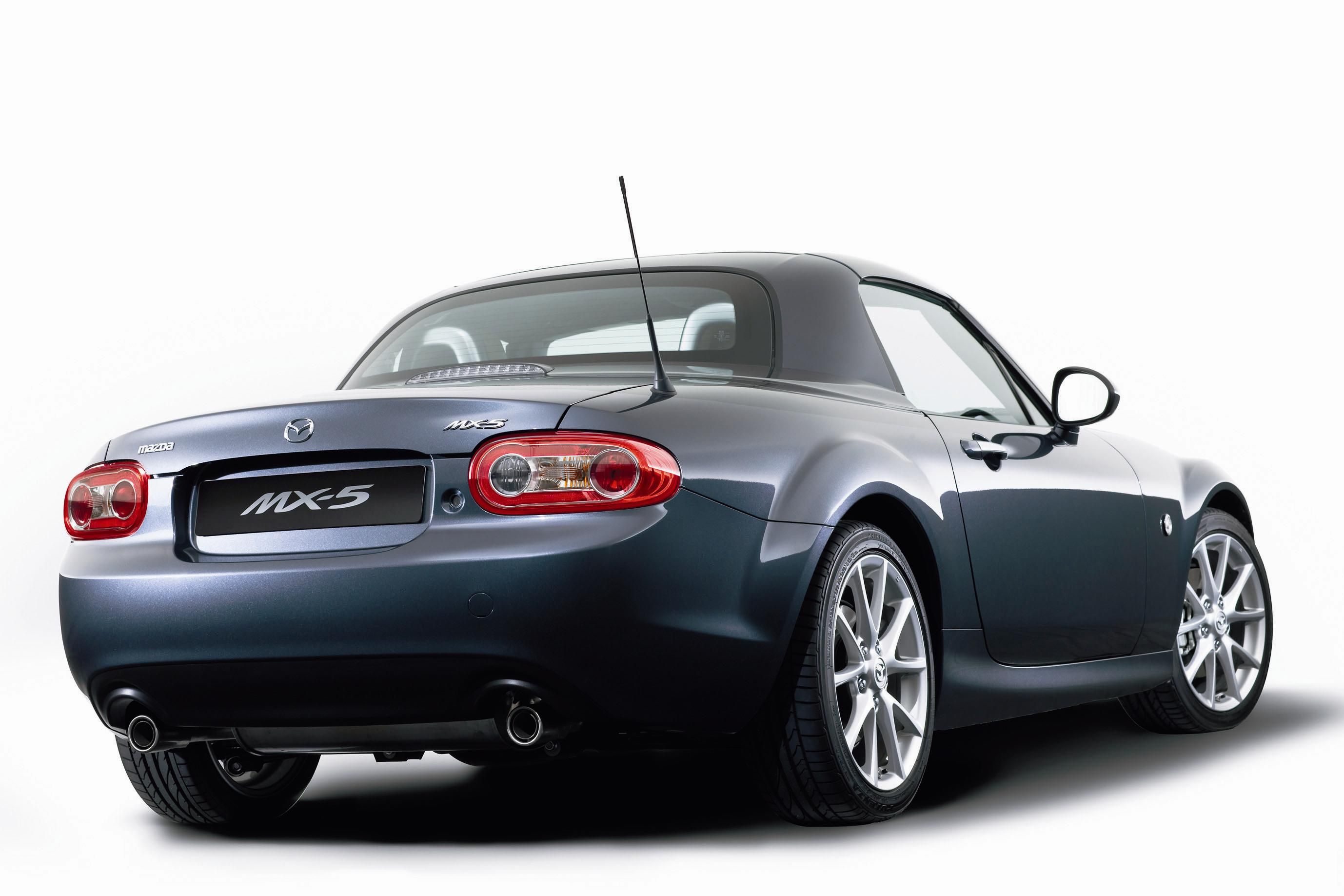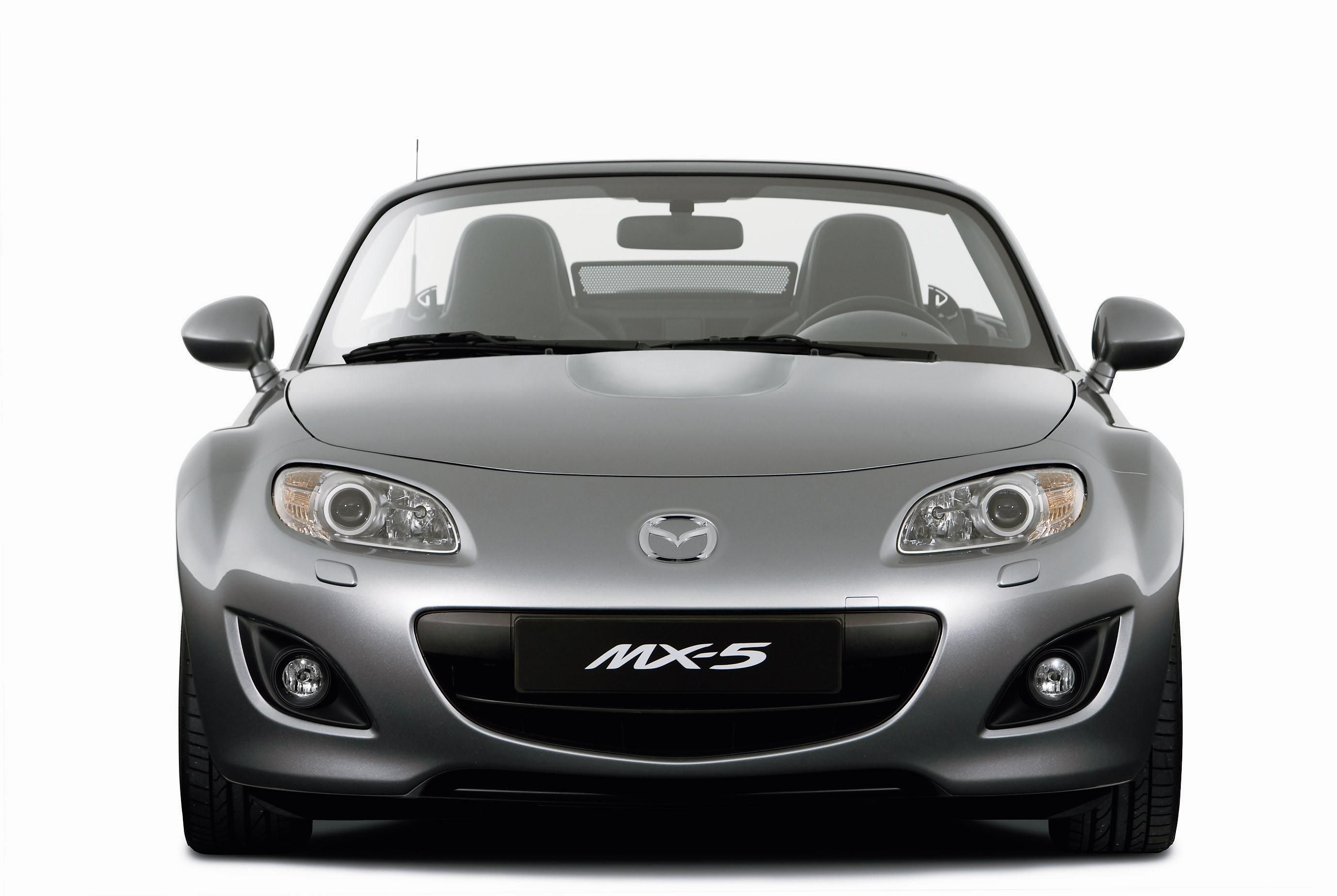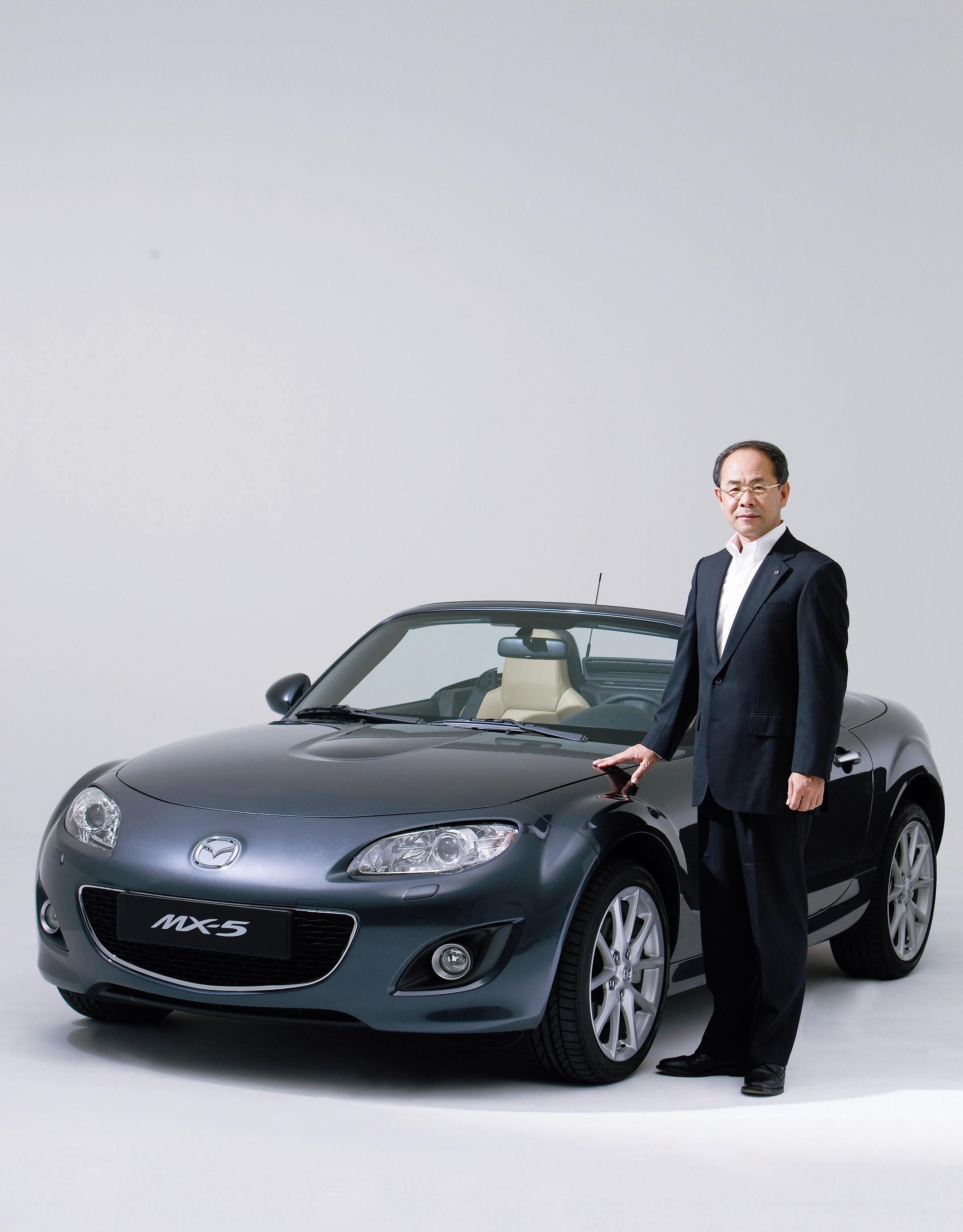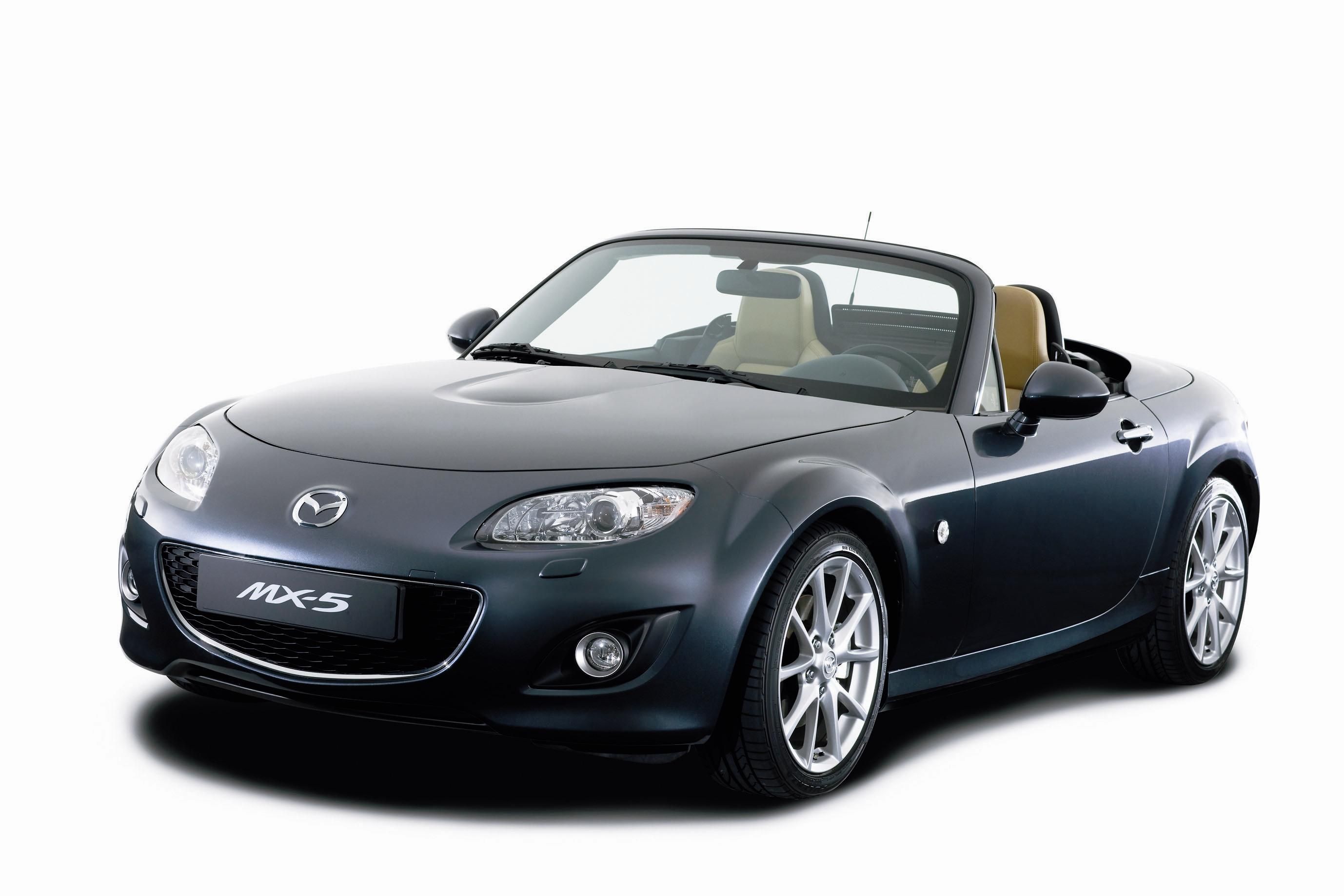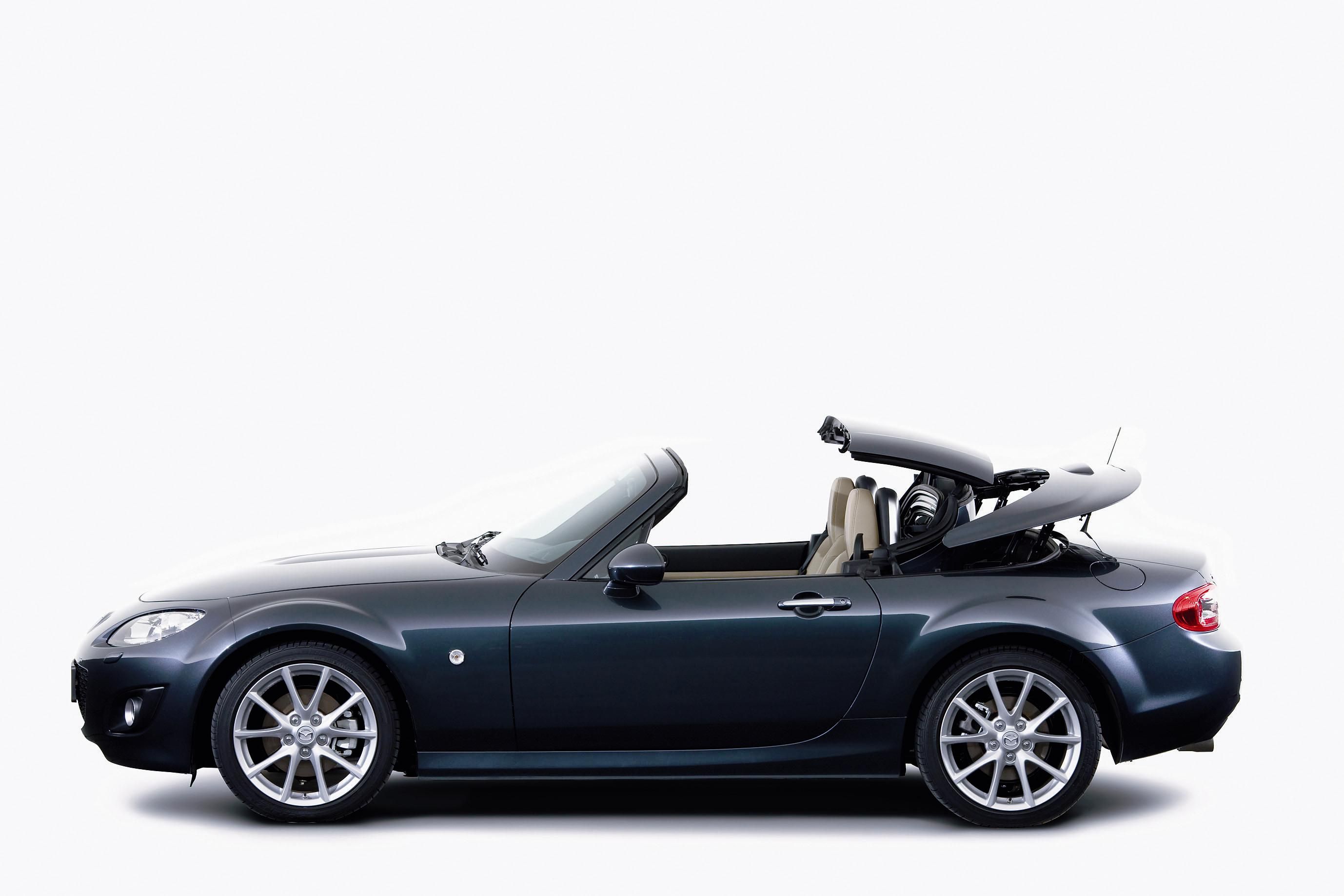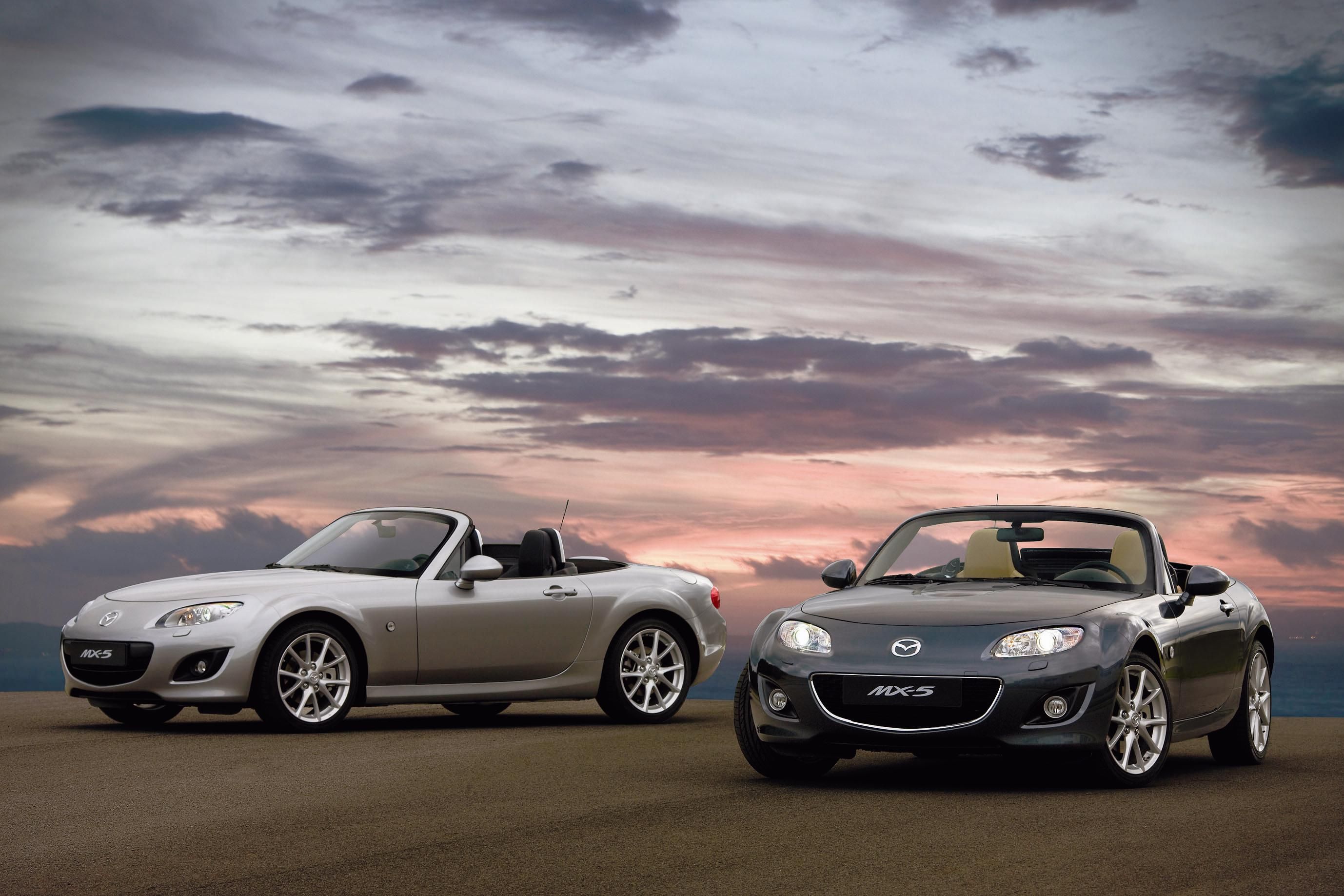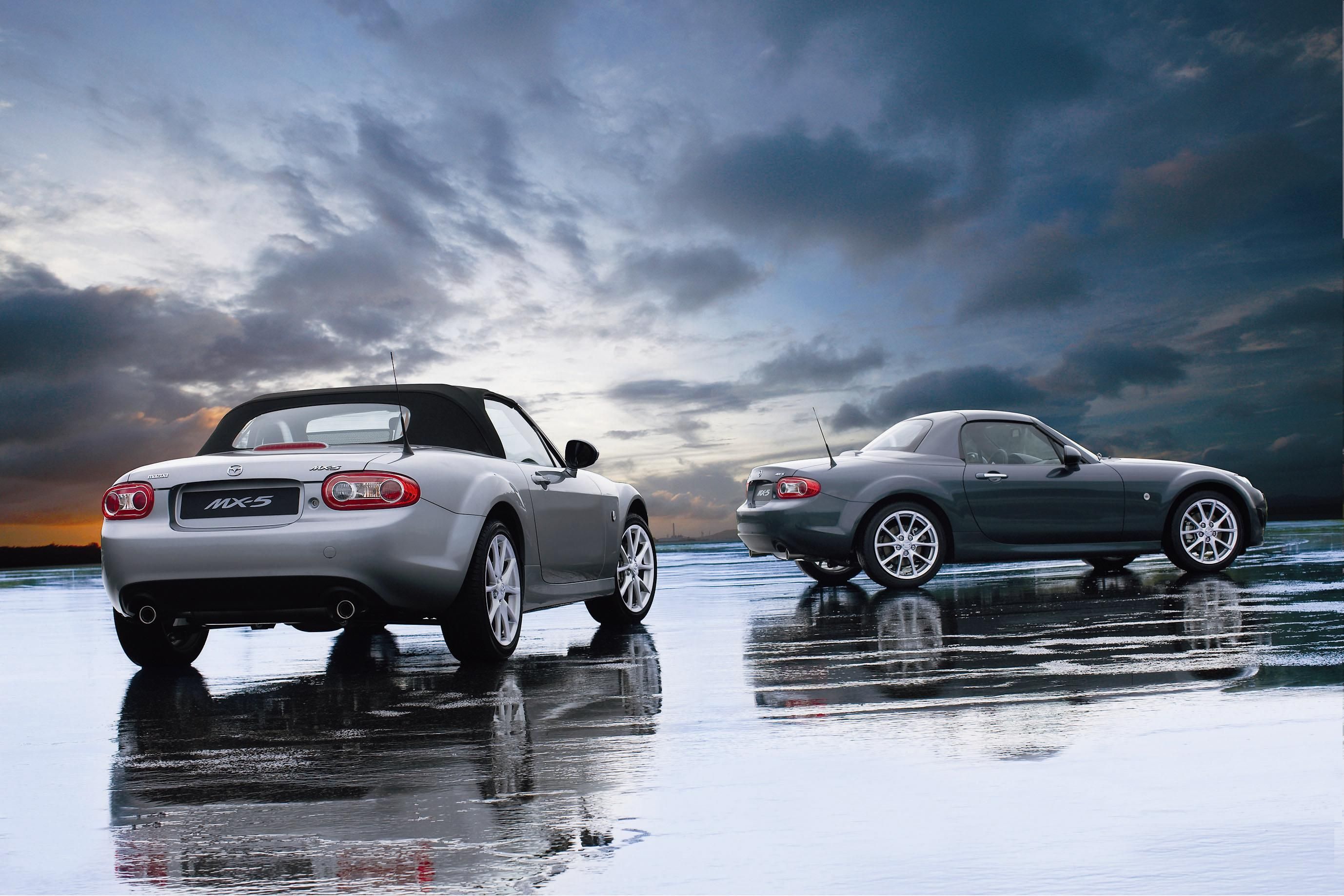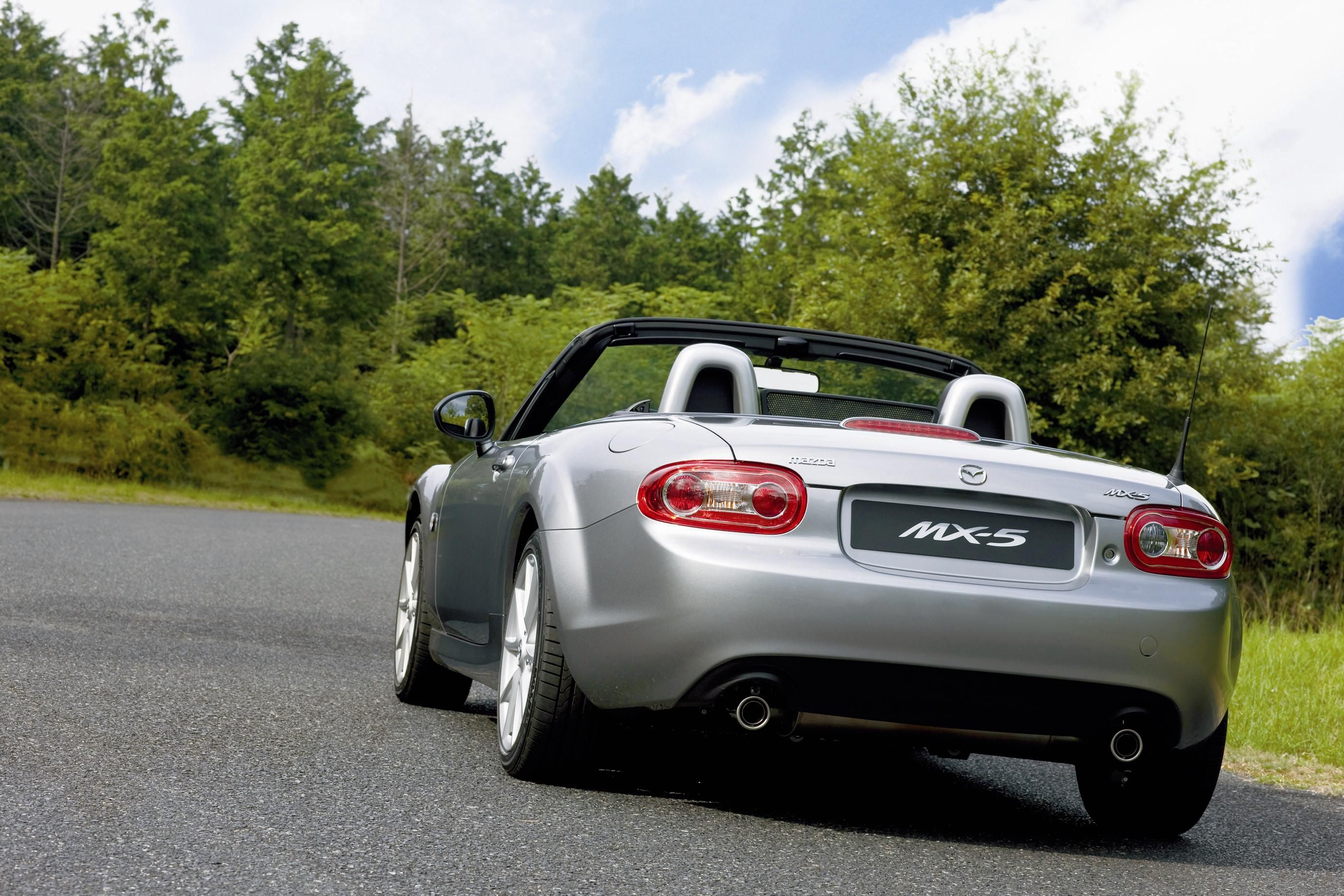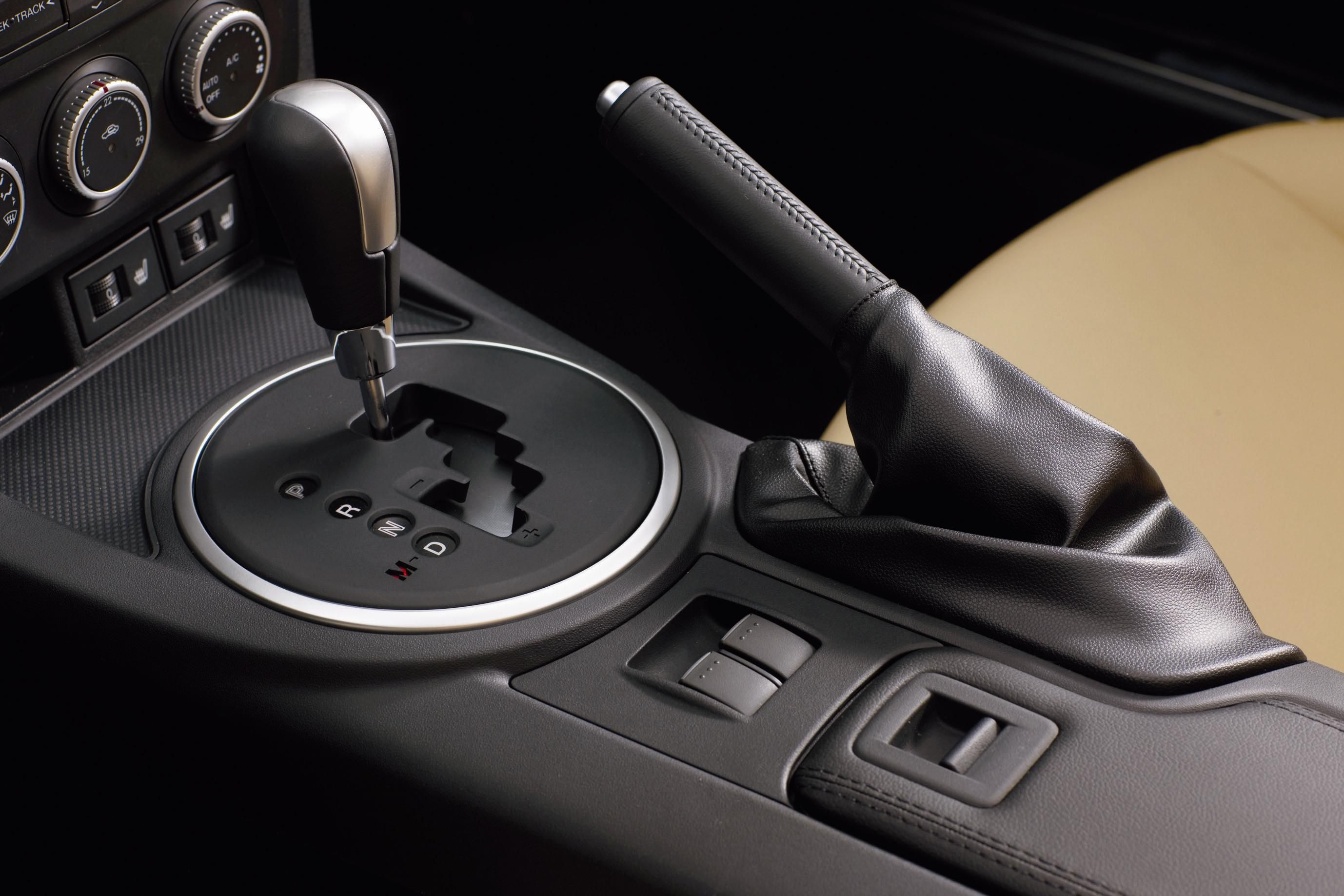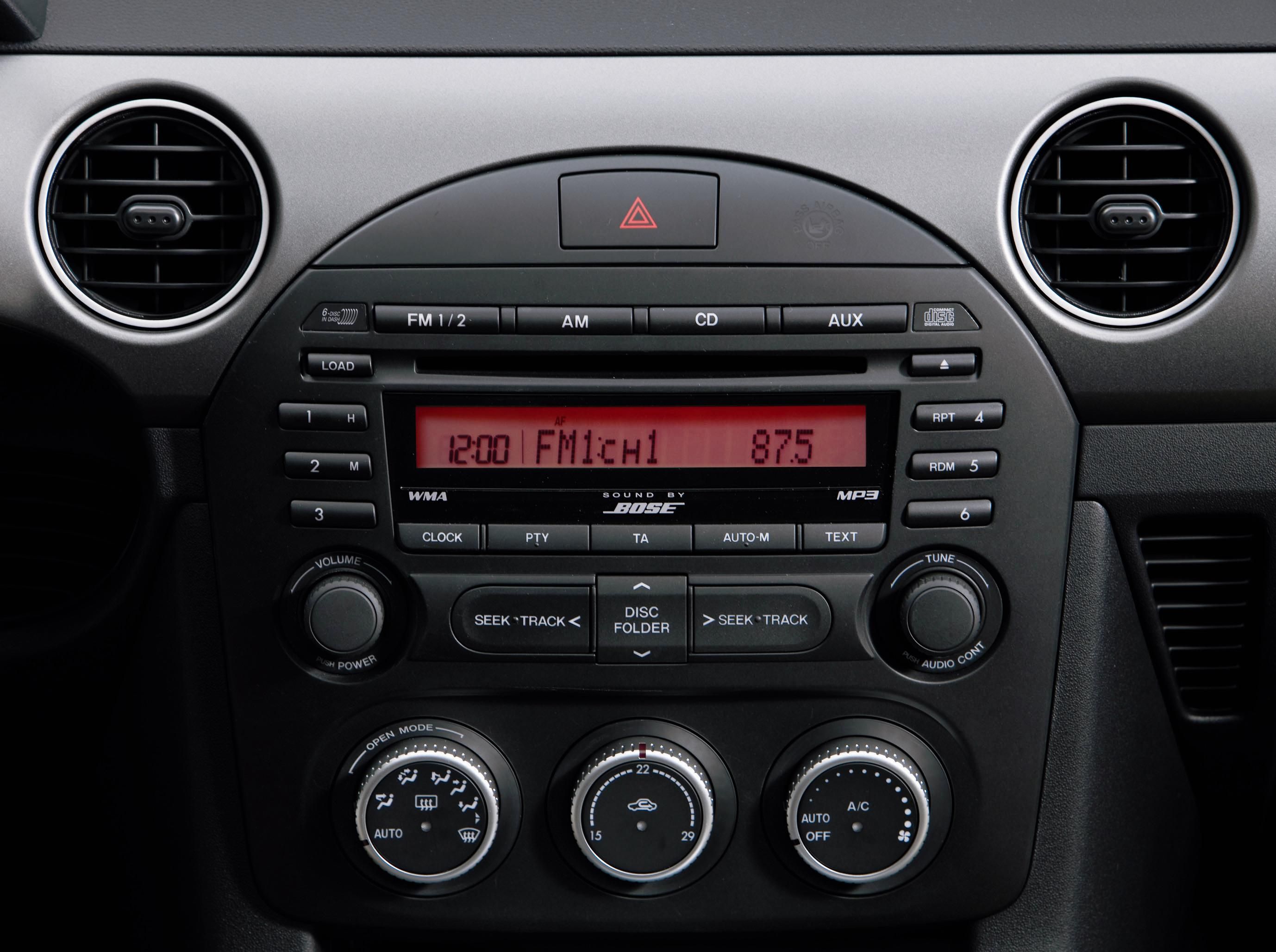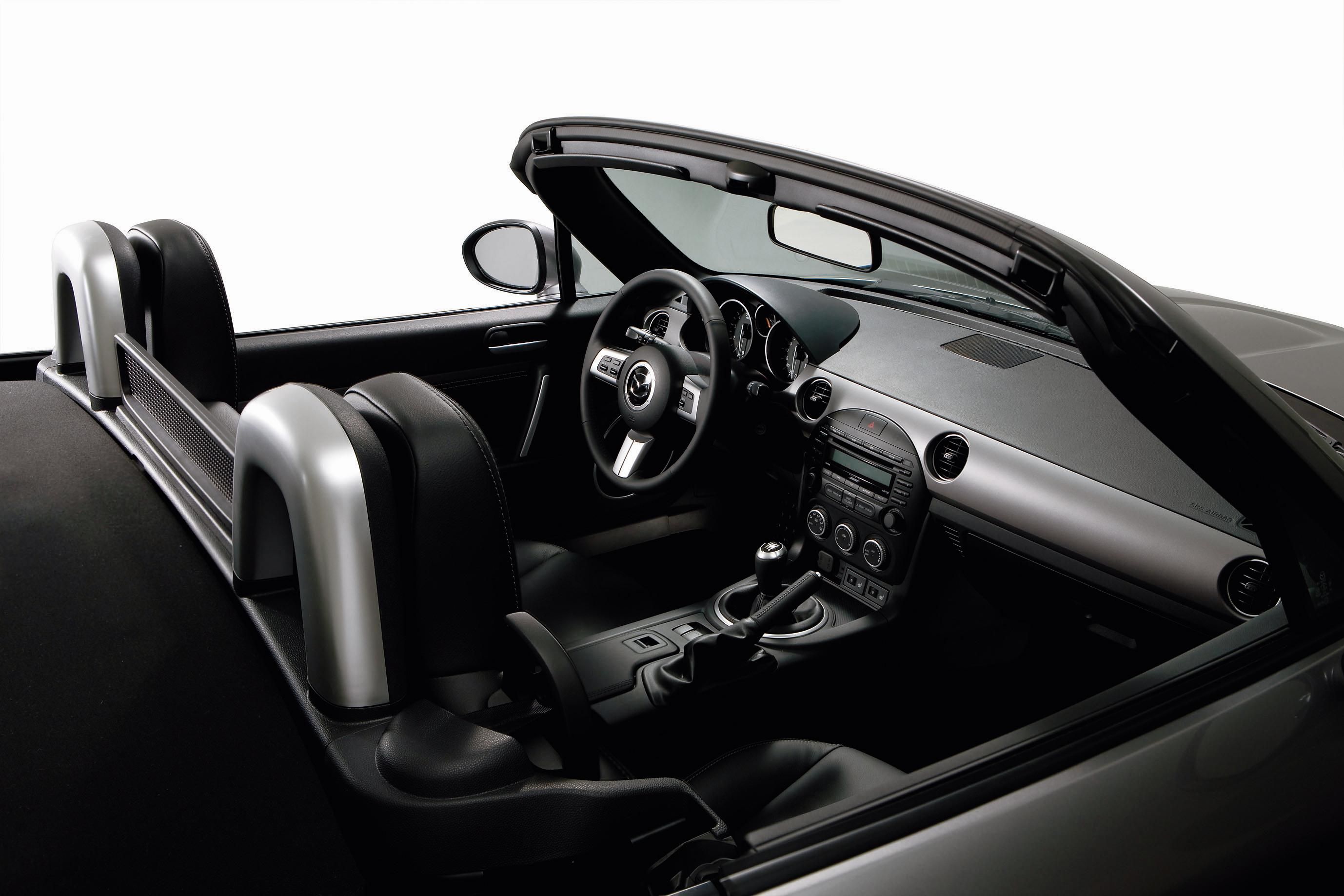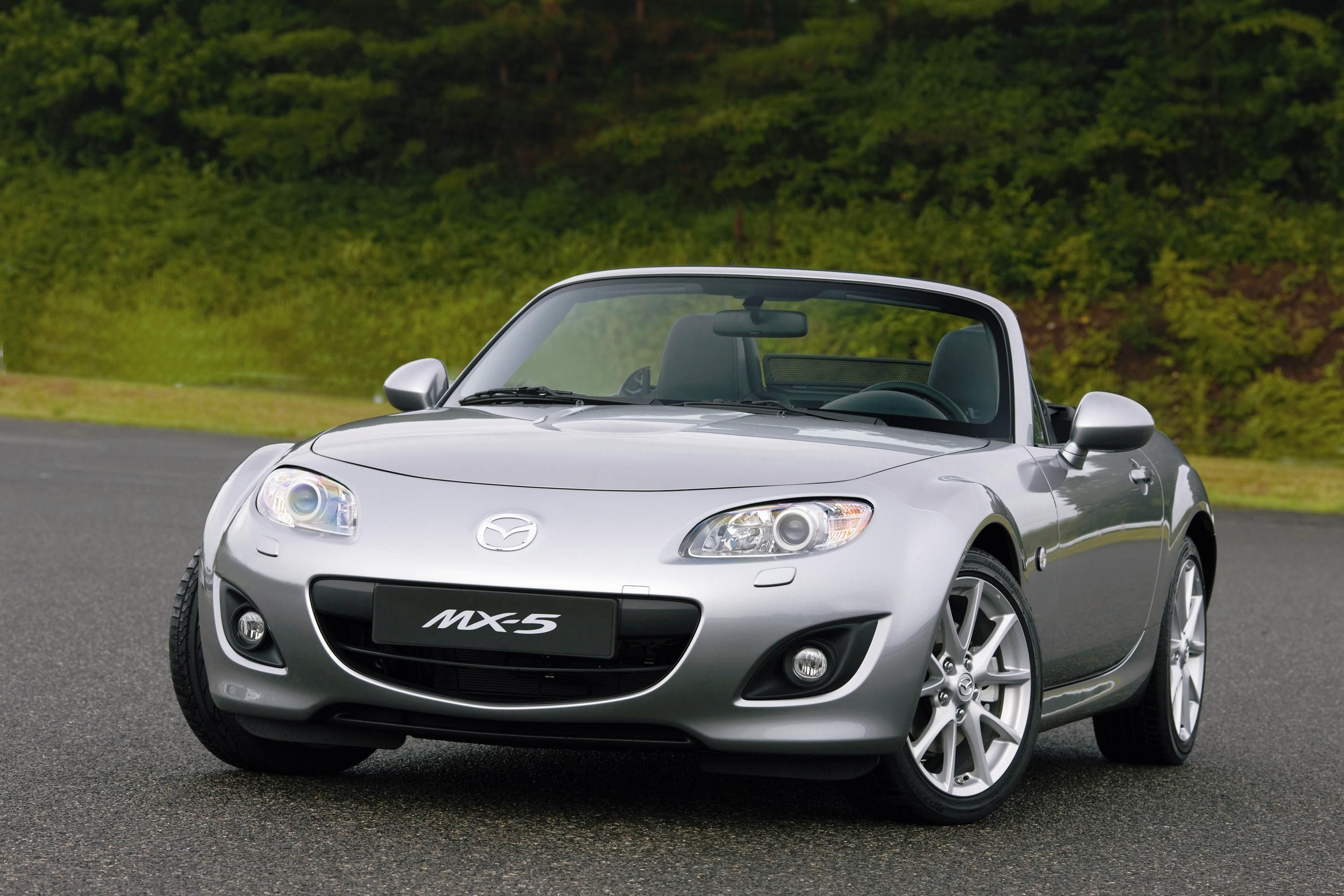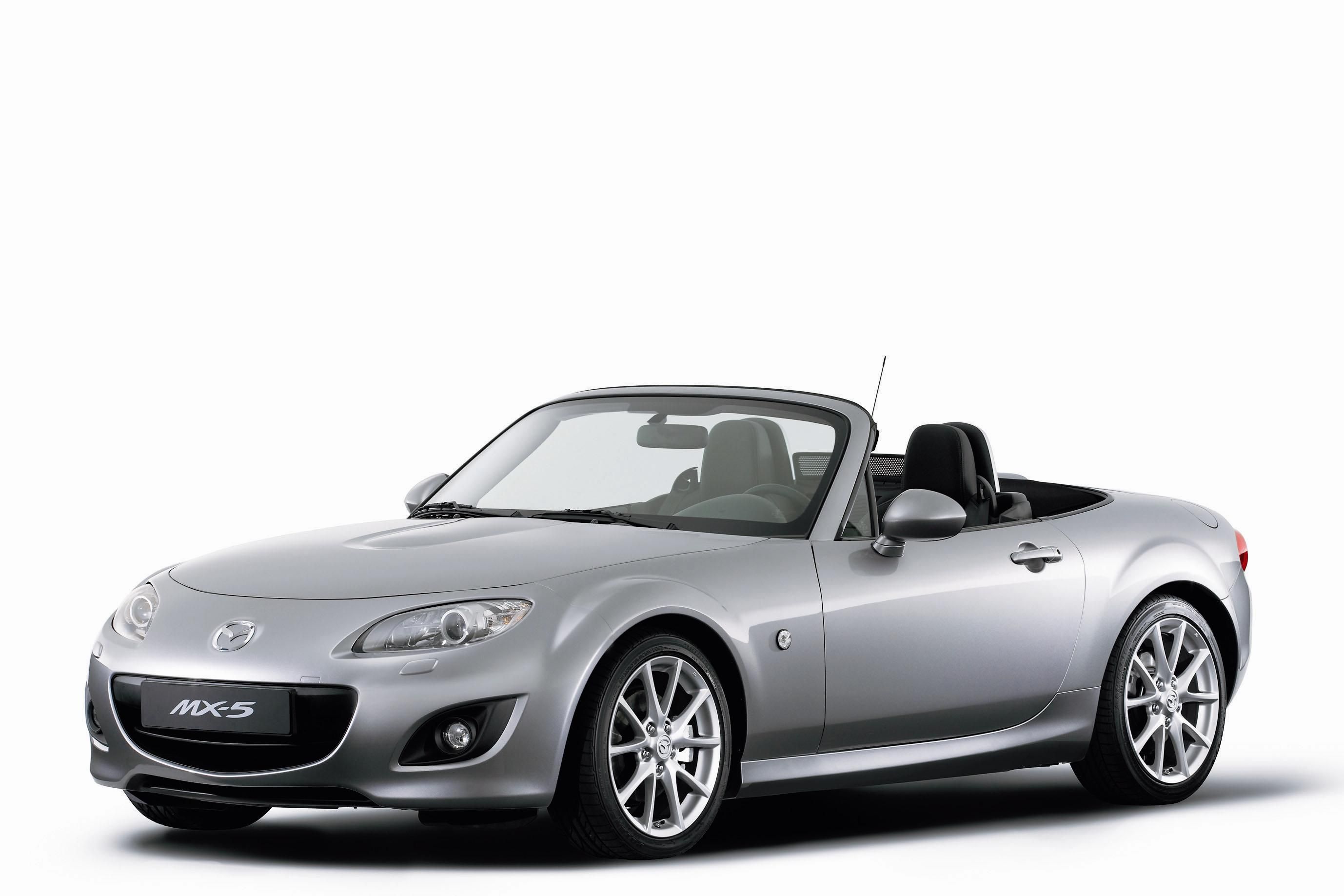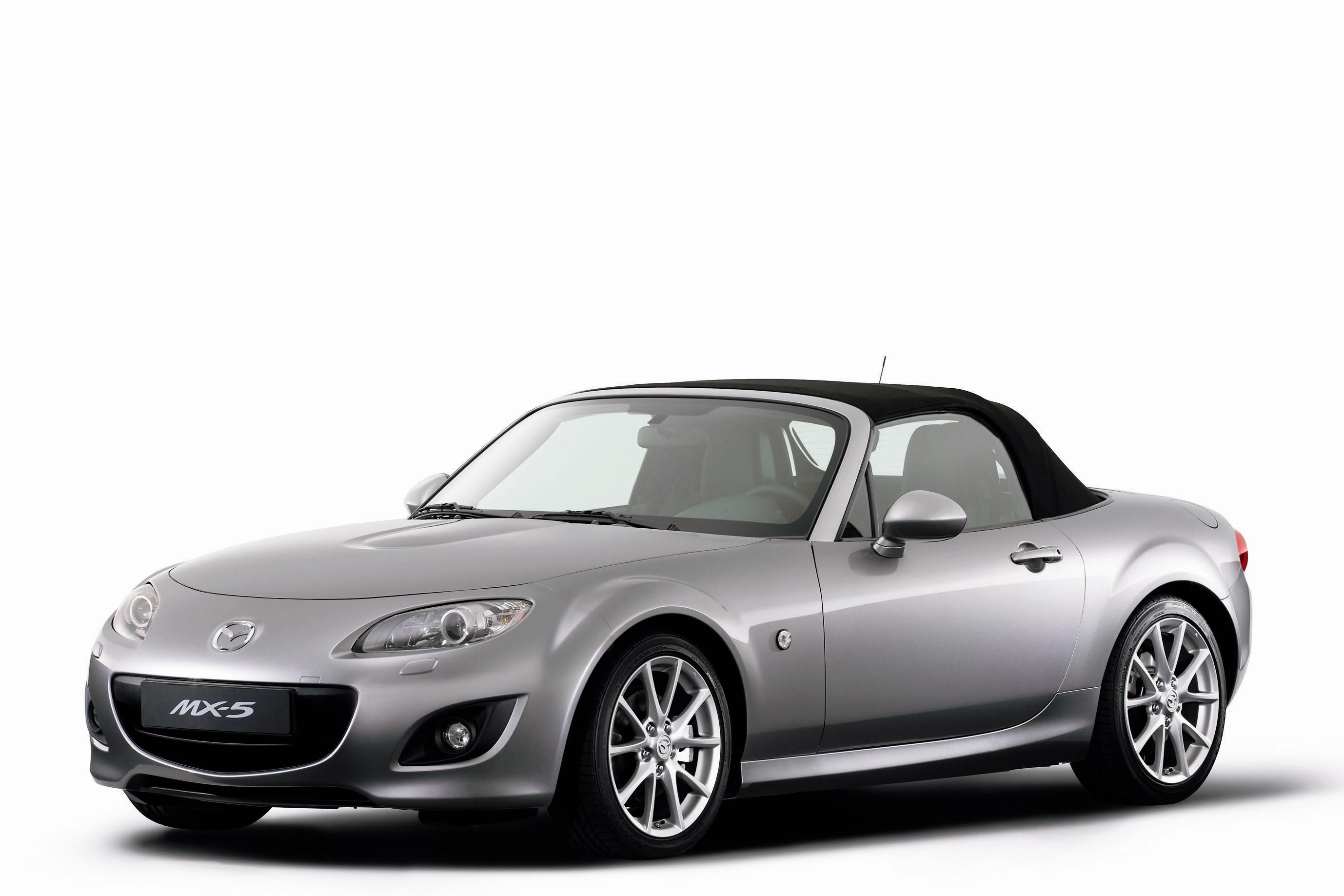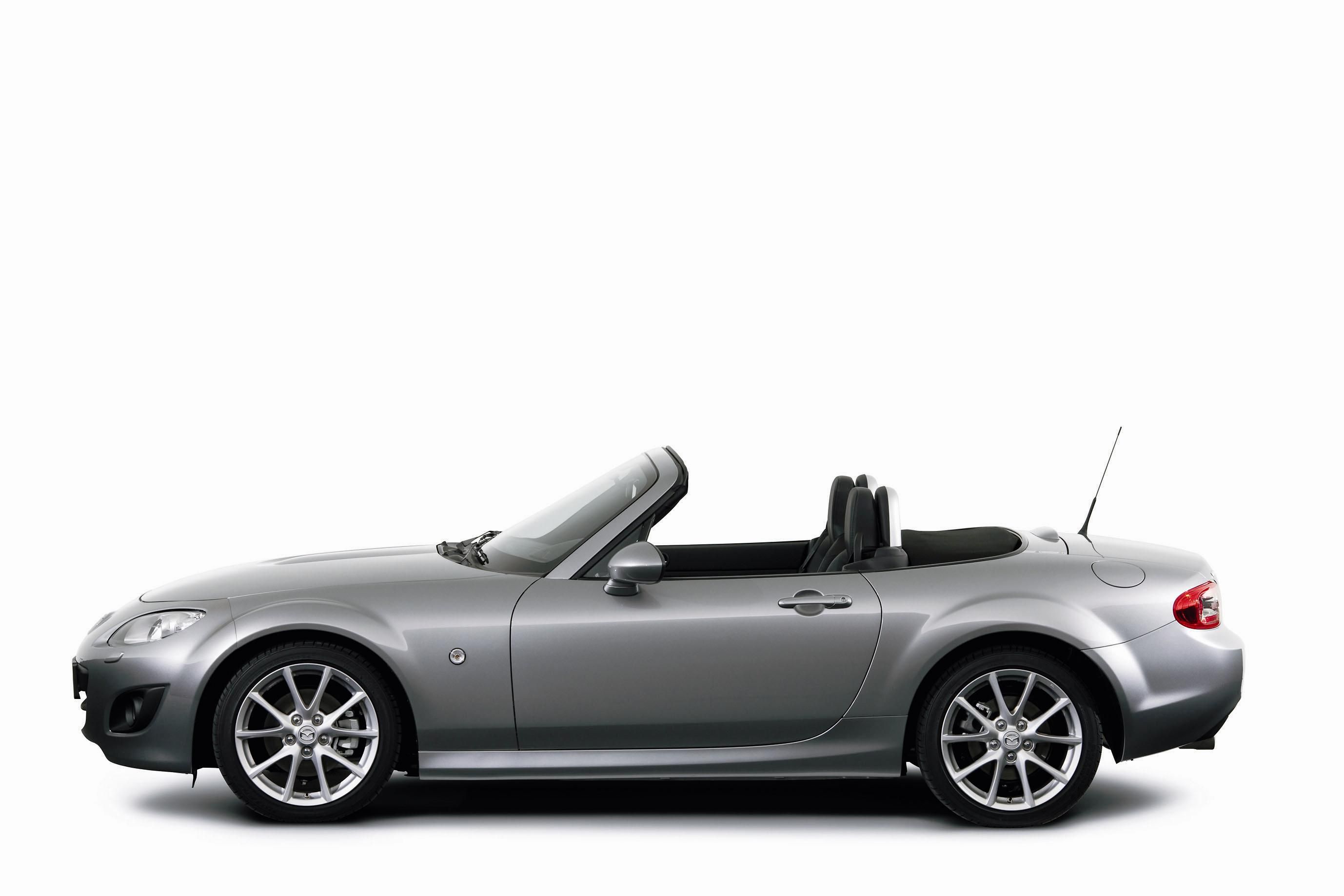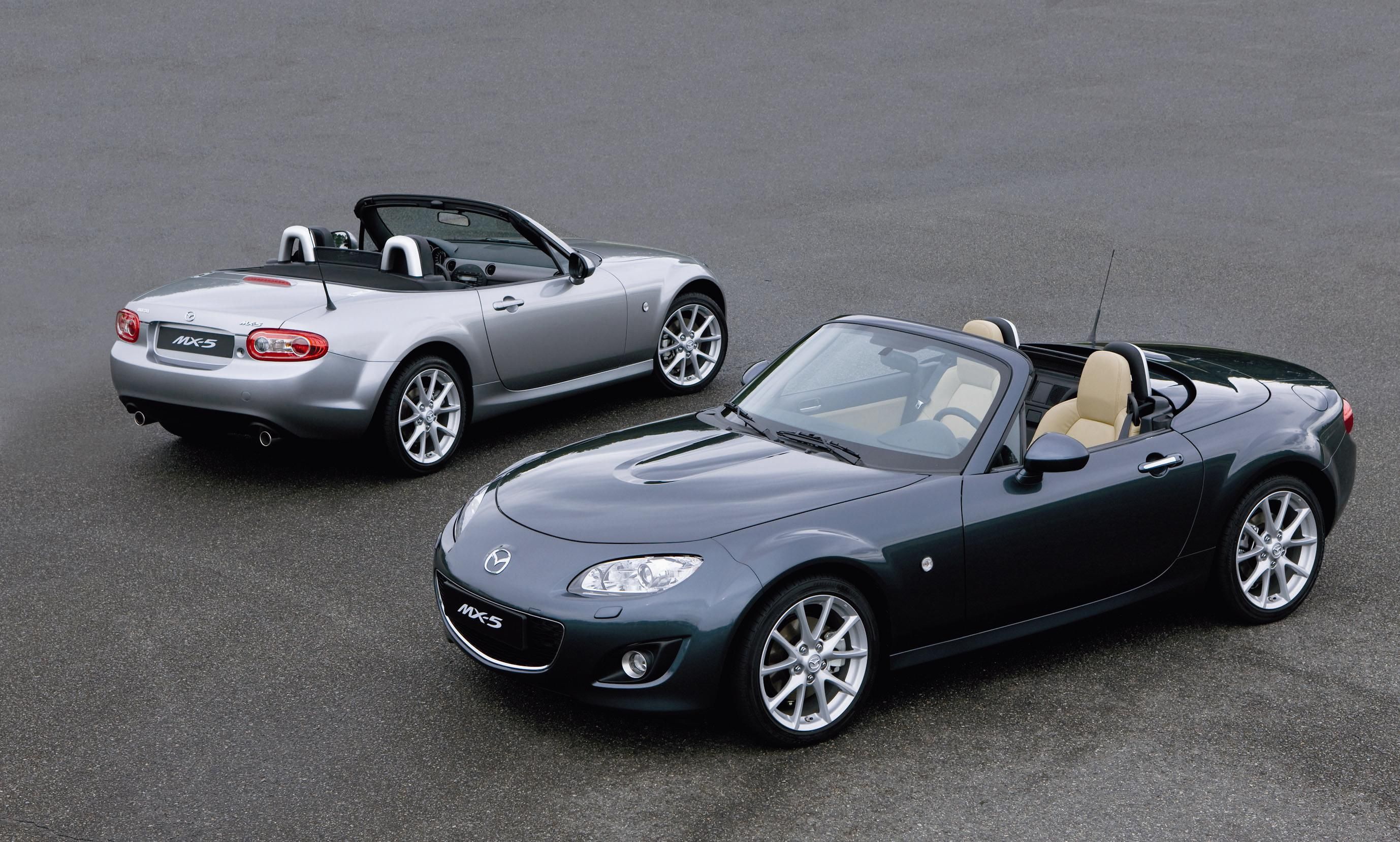Mazda unveiled at the Paris Auto Show the freshened Mazda MX-5 and Mazda MX-5 Roadster Coupe. The MX-5 facelift will be introduced on the European market in early spring 2009.
The powertrain has been enhanced to enable the driver to enjoy the full potential of the engine’s performance (a key “fun to drive” aspect of the MX-5). Specifically, the speed at which the engine delivers maximum power has been raised from 6,700 rpm to 7,000 rpm (2.0-litre M/T version) and the rev limit has been raised from 7,000 rpm to 7,500 rpm (all 2.0-litre versions).
With the six-speed manual transmission, the meshing surfaces of the 1st–4th triple-cone synchronizers are now carbon coated, and the 3rd–4th synchronizer diameter has been increased. These improvements enable smoother shifts up to the engine’s heightened rev limit of 7,500 rpm.
A six-speed Activematic automatic transmission that’s newly available with the MX-5 for Europe incorporates two new control technologies. One is Direct Activematic (DAM), which allows the driver to quickly change gears using paddles on the steering wheel while still driving in the “D” range.
Press release after the jump.
2009 Mazda MX-5
- Make: Array
- Model: 2009 Mazda MX-5
- [do not use] Vehicle Model: Array
Press release
At the 2008 Paris Motor Show, Mazda is unveiling the freshened Mazda MX-5 and Mazda MX-5 Roadster Coupe.* Both versions of the facelifted MX-5 been refined for an even purer experience of Jinba Ittai—the unique feeling of oneness between driver and car that has distinguished the MX-5 since its inception.
Since launching the first-generation MX-5 in 1989, Mazda has stuck to the concept that driving enjoyment is the key value offered by the MX-5. Through two full redesigns and countless improvements, we’ve continued to heighten and improve the MX-5’s Jinba Ittai-focused “lots of fun” character. We expanded the MX-5’s appeal to an even broader audience in 2006 with the launch of the MX-5 Roadster Coupe. As demands for safety and environmental compatibility have grown amid major changes in the automotive environment, we’ve continued to incorporate new technologies and innovations without compromising the MX-5’s inherent lightness.
With the latest MX-5 facelift, we set out to combine an enhanced Jinba Ittai feeling with revisions that would further cement the MX-5’s reputation as the most enjoyable lightweight two-seat sports car in the world. With the design, we retained the well-known friendly facial expression while incorporating elements of Mazda’s latest design themes for a dynamic, athletic look that embodies the MX-5’s function and purpose as a sports car. With the Roadster Coupe, we strongly emphasized a premium identity in the look and feel of the body and cabin.
With regard to dynamic performance, we enhanced characteristics that appeal to the emotions yet cannot be expressed in terms of catalogue specifications. For example, we optimized the engine potential for greater enjoyment, created a sportier engine sound that responds more crisply to accelerator inputs, and realized a brisk, high-quality steering feel that gives a more linear response to movements of the steering wheel. And at the same time, we enhanced the MX-5 in terms of comfort, convenience, fuel economy, and safety.
MX-5 Programme Manager Takao Kijima says: “Although the kind of driving experience that people find enjoyable in a lightweight sports car never really changes, maintaining it in a vehicle that must also meet the continually changing demands of society is a daily challenge for Mazda engineers, and a particularly vital mission with the MX-5. Speaking as the engineer
in charge of MX-5 development, I’m convinced that the MX-5 is—and will remain—more enjoyable than any competing car. I’m delighted that the new MX-5 and the newly evolved Jinba Ittai fun that it offers will soon be thrilling customers who already embrace the MX-5 philosophy, and those who are about to encounter the MX-5 for the first time.”
*The version with a retractable hard top has various names according to market. In Europe, it’s called the Mazda MX-5 Roadster Coupe. In North America, it’s called the Mazda MX-5 Power Retractable Hard Top. And in Japan, it’s called the Mazda Roadster Power Retractable Hard Top.
Heritage
Worldwide Acclaim and More than 850,000 Units of Production
The MX-5 has enjoyed worldwide popularity since its first-generation debut in 1989. Indeed, it is recognized by Guinness World Records as the world’s highest-selling two-seat convertible sports car in history. Since the launch of the third-generation model, the MX-5 has won more than 175 accolades including the 2005–2006 Japan Car of the Year award; Wheels
magazine’s 2005 Car of the Year award; Top Gear magazine’s Roadster of the Year 2005 award; a place in Car and Driver magazine’s 2006 Ten Best Cars list; and selection by Consumer Reports as the best 2008 car in the “fun to drive” category. Aggregate MX-5 production stood at 852,682 units at the end of July 2008, which looks set to be recognized again by Guinness World Records as the highest-ever production volume for a two-seat convertible sports car.
MX-5’s “Lots of Fun” Character
The “lots of fun” character conceived by Mazda for the MX-5 encompasses several kinds of fun: the fun of driving it, the fun of seeing its great styling, the fun of personalizing it, the fun of using it to get together with friends, and the fun of owning and using the MX-5 on a day-to-day basis. And underpinning this “lots of fun” character is the feeling that Mazda calls Jinba Ittai.
An Uncompromising Focus on Lightness
In the third-generation MX-5’s development, Mazda engineers pursued the ‘gram’ strategy (a programme of weight minimization on a component-by-component basis), used cutting-edge technologies to make the body light and rigid, and adopted materials that were stronger and lighter than those used in the second-generation MX-5. As a result, they were able to limit the overall weight increase to just 10 kg (22 lb) and enhance performance at the same time. With the latest facelift, the development team adopted new mechanicals and equipment throughout the MX-5 but again kept the overall weight increase to an absolute minimum. The MX-5’s ideal 50:50 front/rear weight distribution and the reduced yaw-inertia moment achieved by Mazda with the third-generation MX-5 are totally uncompromised.
Design
A Newly Evolved Look that’s Functional and Instantly Recognizable Design and craftsmanship, which are encompassed, respectively, by the “styling” and “touching” categories in the fishbone chart, are particularly crucial to a sports car since they’re the main source of the car’s “fun to own” and “fun to use” characteristics. They must complement and underpin the car’s functionality. With the latest MX-5 facelift, the development team incorporated elements of Mazda’s newest design themes while carefully carrying forward the simple and instantly recognizable personality that Mazda established with the
first-generation MX-5. The updated exterior styling reflects an evolution toward greater dynamism and athleticism, and it contributes to superior aerodynamic performance. The updated interior design realizes significantly enhanced quality and a more functional, driver-friendly sports-car cockpit.
Exterior Design: A Fusion of New Mazda Elements and an Unmistakable MX-5 Look
The front grille has been enlarged and changed from an oval shape to the five-point grille that forms part of the well-known Mazda family face. Combined with tautly styled headlights and flowing fog-lamp bezels, the new grille creates a refined and athletic expression. To preserve the character that has always been a hallmark of the MX-5, the five points of the grille are
slightly rounded. Also, the new shape of the front bumper, with corners that extend downwards, enhances the dynamic look and improves the aerodynamics.
Viewed from the side, newly designed side sills form a character line that flows to the rear bumper in a way that emphasizes speed and stability. The reshaped side sills deflect air away from the rear wheels, and thereby contribute to superior aerodynamic performance. The rear bumper has a new design that makes the rear look wider, sportier, and more integrated into the body. The rear combination lamps inherit the traditional MX-5 elliptical motif, and protrude further outboard for greater aerodynamic efficiency.
The Roadster Coupe’s more Upscale Identity
The MX-5 Roadster Coupe, which features a groundbreaking powered roof system, also incorporates several design changes that further emphasize its more upscale identity and distinguish it from the soft-top version.
- Front grille: Whereas the soft-top version has a fin-type grille, the Roadster Coupe has amesh grille that is framed by a chrome ring. Headlamp inner bezels: The headlamp inner bezels are painted silver on the soft-top version, but have a chrome finish on the Roadster Coupe.
- Fog-lamp inner bezels: The fog lamp inner bezels are black on the soft-top version, but are painted silver on the Roadster Coupe.
- Outer door handles: The outer door handles are body-coloured on the soft-top version, but have a chrome finish on the Roadster Coupe.
- High-mounted stop lamp: The high-mounted stop lamp has a red lens on the soft-top version, but a clear lens on the Roadster Coupe.
New Wheel Designs
The MX-5 is available with 16-inch and 17-inch aluminium wheels. The 16-inch wheels have five sets of twin spokes for a lightweight look. The 17-inch wheels have 10 twisted spokes for a stronger impression of power and dynamism.
Interior Design: Higher Than Ever Quality and Driver-Friendliness
The interior design delivers the MX-5’s traditional combination of comfortable snugness below shoulder level and openness above shoulder level. It also reflects customer feedback in the form of enhanced quality and driver-friendly features.
The decorative surfaces on the instrument panel have been changed from glossy piano black to dark silver, which has a subtler, higher-quality look befitting a sports car. The meters have new graphics for higher legibility. The climate-control dials on the centre stack have each been given a silver-coloured ring for a higher-quality look. A protrusion has been eliminated from the outer surface of each door pocket to create more leg space. And the door and centre-console armrests have each been given a soft pad for a better feel.
Recaro seats designed exclusively for the MX-5 are available in certain regions. They are upholstered in leather and perforated Alcantara® for a sporty look, and they combine excellent support with easy ingress and egress.
Colour Variations
The MX-5 for Europe has a lineup of seven body colours including two new choices: Aluminium Metallic (a mix of sportiness and refinement) and Metropolitan Grey Mica. The soft top is black. Non-Recaro seats in the MX-5 for Europe are upholstered with black fabric or with black or Dune Beige (not available in Europe) leather depending on grade. The leather and perforated
Alcantara® on the Recaro seats have a black-based two-tone colour scheme. The full lineup of body colours is as follows:
- Aluminium Metallic (new)
- Metropolitan Grey Mica (new)
- Sunflower Yellow (new; not available in Europe)
- Copper Red Mica
- Stormy Blue Mica
- True Red
- Brilliant Black
- Marble White (soft-top version only)
Dynamic Performance
Evolved Jinba Ittai for Enhanced Fun-To-Drive
The Jinba Ittai feeling on which Mazda has always focused with the MX-5 defines the kind of spontaneous car-and-driver interaction that anyone can experience whether they’re driving the MX-5 in town, on twisty roads, or on an open highway. With the latest facelift, Mazda engineers evolved the attributes in the “driving”, “cornering”, “braking”, and “listening” categories in the fishbone chart to realize performance that lets drivers enjoy the feeling of oneness with the car
to an even greater degree.
A 500 rpm Higher Rev Limit Maximizes Engine Potential for Greater Enjoyment
The powertrain has been enhanced to enable the driver to enjoy the full potential of the engine’s performance (a key “fun to drive” aspect of the MX-5). Specifically, the speed at which the engine delivers maximum power has been raised from 6,700 rpm to 7,000 rpm (2.0-litre M/T version) and the rev limit has been raised from 7,000 rpm to 7,500 rpm (all 2.0-litre versions). Without these enhancements, the engine feels smooth and linear right up to the rev limit, even with the throttle wide open. With them, however, the driver can really experience the sensation of extracting every single horsepower out of the engine (the enhancements described here apply to the 2.0-litre grades with a manual transmission). The crucial 500 rpm increase in the rev limit is enabled by greater precision in the engine, namely: a forged crankshaft (this ensures the required rigidity at high engine speeds), fully floating pistons and newly designed valve springs.
A Sportier Engine Sound that Responds More Crisply to Accelerator Inputs
The engine sound (a key element in the “listening” category of the MX-5 fishbone chart) is a big part of the sports car experience. With the latest facelift, Mazda engineers made the great MX-5 engine sound even better without causing aural discomfort for people outside the car. Notably, they increased the rigidity of the plastic surge tank in the intake manifold. The optimized surge tank combines with the new forged crankshaft to realize a clearer engine sound throughout the rev range. In vehicles with the six-speed manual transmission, the engineers also adopted a newly developed device called an Induction Sound Enhancer (ISE).
This amplifies the pulses that occur when an accelerator input opens the throttle valve to increase air flow into the engine, thereby delivering a more exciting sound to the cockpit. The intake sound created by the ISE feels synchronized with the driver’s accelerator inputs, so the driver enjoys a crisp, thrilling engine sound even when using the accelerator pedal gently to adjust the revs for a downshift.
Newly Evolved and Refined Transmissions
With the six-speed manual transmission, the meshing surfaces of the 1st–4th triple-cone synchronizers are now carbon coated, and the 3rd–4th synchronizer diameter has been increased. These improvements enable smoother shifts up to the engine’s heightened rev limit of 7,500 rpm.
A six-speed Activematic automatic transmission that’s newly available with the MX-5 for Europe incorporates two new control technologies. One is Direct Activematic (DAM), which allows the driver to quickly change gears using paddles on the steering wheel while still driving in the “D” range. It was developed to enable quick downshifts for three common situations: decelerating using engine braking on a downhill road; accelerating after decelerating into a corner; and overtaking another vehicle. (The driver does not need to select the “M” range before shifting down.) Since Direct Activematic enables engine braking and acceleration more quickly and easily, it makes driving easier and more fun. The other new technology is Active Adaptive Shift (AAS), by means of which the transmission control system evaluates the driving situation from factors such as the road’s gradient and twistiness and the accelerator and brake inputs. When the system recognizes enthusiastic driving, it actively promotes upshifts and downshifts to realize a linear and sporty response that matches the driver’s intentions.
Handling that Further Heightens the Jinba Ittai Feeling
The MX-5 development team also heightened the Jinba Ittai feeling by comprehensively refining attributes in the category that’s called “cornering” on the fishbone chart. A key refinement was made to the front suspension knuckles. The ball joints’ vertical pivot position was changed to reduce the height of the front roll centre by 26 mm. This decreased fluctuations in the vertical loading on the outer wheel during cornering manoeuvres. Consequently, roll movements caused by steering inputs feel more natural and the car’s response to steering inputs is more linear. In combination with newly tuned suspension components, the revision improves the Jinba Ittai steering feel whereby the driver can precisely trace desired lines. It also realizes a higher-quality ride by making the yaw and roll feel more natural.
An Athletic Design that Heightens Aerodynamic Performance
To improve handling stability, quietness, and high-speed fuel economy, the MX-5 development team drew on Mazda’s expertise in incorporating aerodynamic improvements into styling that’s faithful to a design theme. The main aerodynamic improvements are as follows:
- air guides that protrude downward from the left and right corners of the front bumper
- a cover over the lower opening in the front bumper (Europe-specification vehicles, except some specific markets)
- protruding rear combination lamps
- wider front tyre deflectors
As a result of these improvements, both the soft-top version and Roadster Coupe have top class aerodynamics for their class.
Comfort and Utility
A Quieter Ride in the Roadster Coupe
Given the Roadster Coupe’s more upscale positioning, the development team produced a quieter ride by reducing wheel resonance and adding damping and sound-insulating materials, such as urethane filling in the front suspension crossmember and damping material in the front part of the roof. Thanks to these improvements, road noise in the cockpit on a coarse road surface with the roof closed is 2.1dB lower than before. Quietness is further promoted in the Roadster Coupe and soft-top version by stiffer door modules and by newly added reinforcements on the No. 2 crossmember.
New Equipment for Comfort and Convenience
- Bose® sound system (optional): New features such as a six channel equalizer (with separate channels for the woofers and the door-mounted mid-to-high frequency speakers) achieve clearer, more dynamic sound reproduction. AUX jack: Third-party audio devices can be connected to the car’s audio system. There is also a 12V power socket.
- Bluetooth telephone system (optional): Hands-free communication is possible without even having to physically plug in Bluetooth-capable mobile telephones. The driver can make and accept calls using voice commands or controls mounted on the steering wheel.
- Improved seat heaters (optional): Shorter warmup times are complemented by five levels of adjustability (as opposed to the previous on/off control) for greater comfort.
- Storage for small items: The divider that forms cupholders in the centre-console can be removed to create a handy box for small items. There is also a net pocket on each door.
Ecology and Safety
Enhanced Environmental Performance for Greater Enjoyment
Mazda regards efforts to reduce fuel economy and exhaust emissions not only as a vital way to protect the environment but also as a way to make sports cars more fun to drive. With the latest MX-5 facelift, Mazda engineers addressed fuel economy by reducing the rolling resistance of the tyres, reducing engine friction, and revising the transmission gear ratios. Lower exhaust emissions were achieved through upgraded precious metals in the catalytic converter. The MX-5’s improved emission performance complies with Japan’s SU-LEV standard, the European Union’s Stage 4 standard, and the United States’ ULEV2
standard.
To promote eco-driving, the digital display on the instrument panel can show the average fuel consumption (The display can be toggled between average fuel consumption, a double tripmeter, and the outside air temperature.)
Rigorous Attention to Safety
Improved active safety on the European MX-5 is realized by expanded availability of a tyre pressure monitoring system and by more models featuring Dynamic Stability Control as standard equipment.
The MX-5 facelift will be introduced on the European market in early spring 2009.

